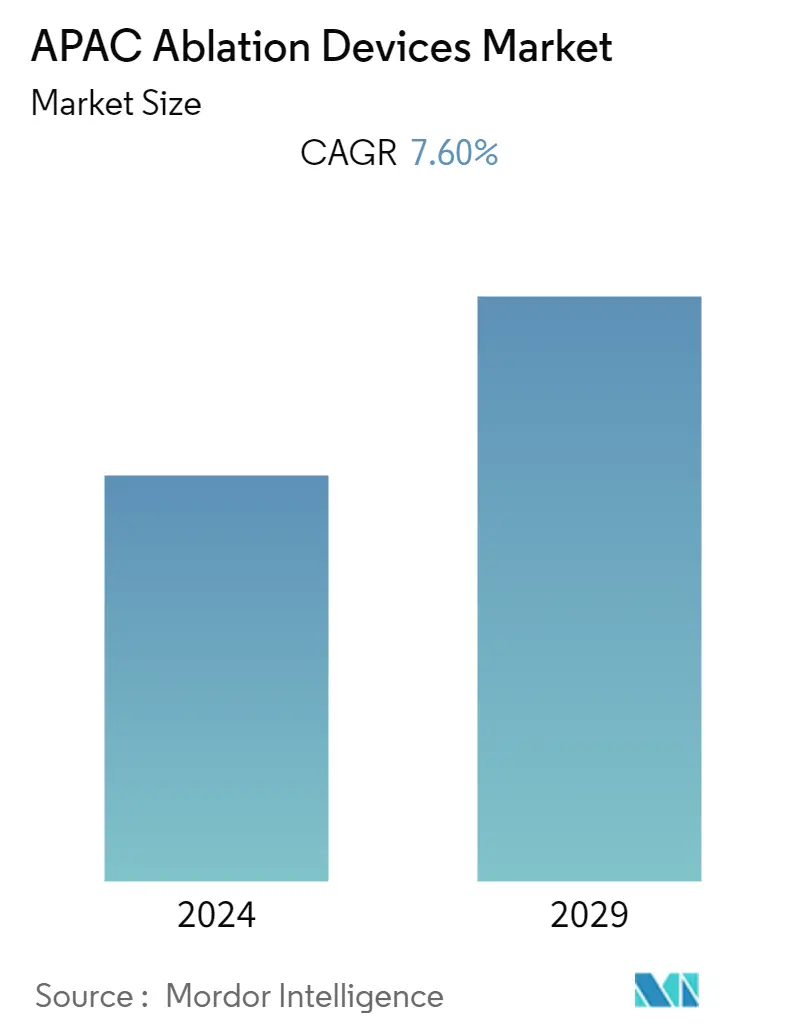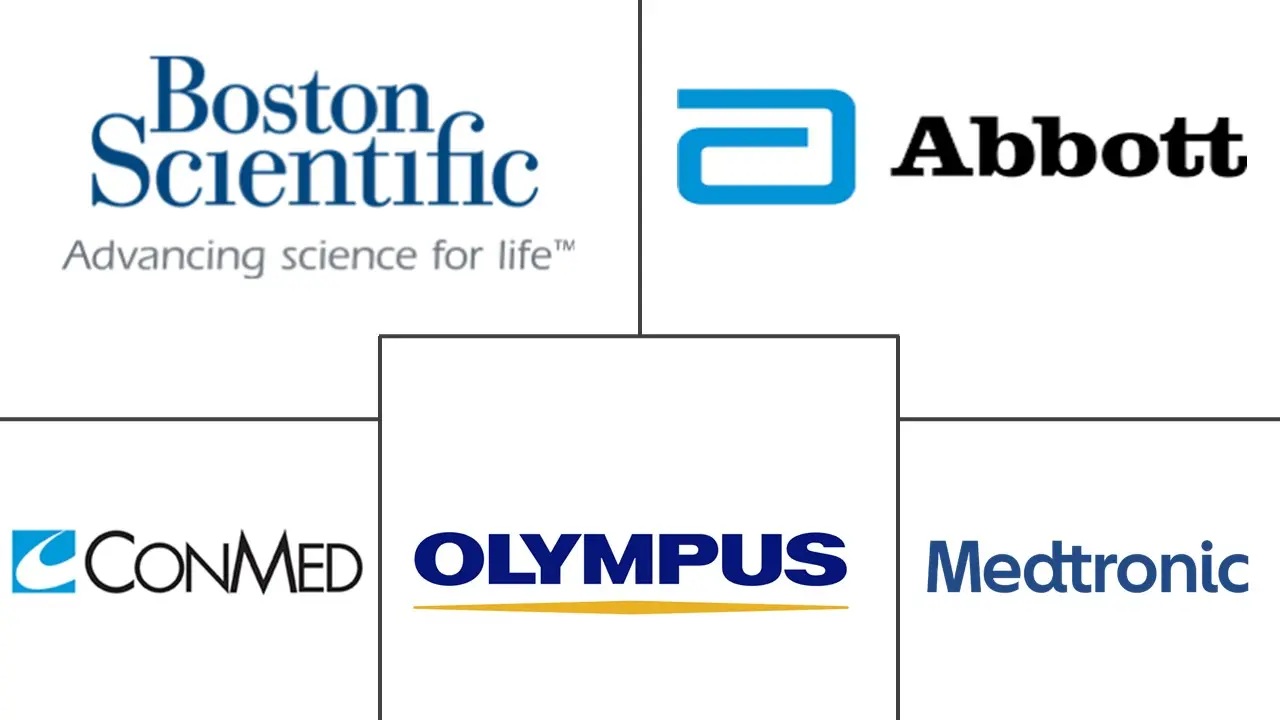Market Size of APAC Ablation Devices Industry

| Study Period | 2019 - 2029 |
| Base Year For Estimation | 2023 |
| Forecast Data Period | 2024 - 2029 |
| Historical Data Period | 2019 - 2022 |
| CAGR | 7.60 % |
| Market Concentration | Low |
Major Players
*Disclaimer: Major Players sorted in no particular order |
APAC Ablation Technologies Market Analysis
The Asia-Pacific Ablation Devices Market is expected to register a CAGR of nearly 7.6% during the forecast period.
The COVID-19 pandemic had a significant impact on the market initially. Due to the lockdown conditions imposed in various Asian countries, surgical procedures reduced considerably including ablation procedures. For instance, according to an article published by the Journal of Clinical Medicine in October 2022, a study was conducted in China which showed that the COVID-19 pandemic had a significant impact on the clinical practice patterns of atrial fibrillation and the catheter ablation and percutaneous left atrial appendage occlusion procedures were significantly reduced. Hence, the COVID-19 pandemic had a significant impact on the market initially. However, as the pandemic has currently subsided, the ablation procedures are expected to take place normally, leading to stable growth of the studied market.
Rising incidences of diseases such as cancer and cardiac ailments are expected to boost the demand for ablation procedures. The technological advancements to design high-end products and growing demand for treatment procedures, which are minimally invasive are also expected to boost the ablation technologies market. Furthermore, the ageing population having a higher risk of target diseases is another vital factor driving the demand for ablation devices.
Japan has a fast ageing population. For instance, according to the data from the 2022 White Paper on Ageing Society, published by the Cabinet Office of Japan, it is estimated that Japan's population aged 65 and over stands at just over 36.21 million in 2021, accounting for 28.9% of the total population. As the geriatric population is expected to increase in coming years who are more prone to chronic diseases such as cancer, cardiovascular diseases, and urinary disorders which are expected to increase the ablation procedures in near future which shows a positive impact on the market.
Furthermore, government initiatives to treat various diseases are also expected to enhance the adoption of ablation devices. For instance, in May 2022, MoHFW of India proposed to increase the number of cataract surgeries to be carried progressively across the country in the financial year 2022-23 to 7.5 million, 9 million in 2023-24, and 10.5 million in 2024-25: amounting to a total of 27 million of surgeries in the next three years.
Moreover, product launches by various market players are also expected to increase market growth. For instance, in November 2021, Medtronic India launched the Arctic Front Cardiac Cryoablation Catheter for the treatment of atrial fibrillation in India.
Therefore, rising prevalence of cancer and other chronic diseases, increasing product launches, and rising geriatric population is expected to enhance the growth of the market over the forecast period. However, high cost of devices, lack of awareness, and stringent regulations are some of the market challenges which is expected to hinder the market growth.
APAC Ablation Technologies Industry Segmentation
As per the scope of the report, ablation generally refers to the removal of a part of biological tissue, usually by surgery. Ablation devices offer a minimally invasive alternative to traditional surgical treatment of liver, prostate, kidney, and lung cancers. The Asia-Pacific Ablation Devices Market is Segmented by Type (Radiofrequency Devices, Laser/Light Ablation, Ultrasound Devices, Cryoablation Devices, and Other Devices), Application (General Surgery, Cardiovascular Disease Treatment, Cancer Treatment, Ophthalmological Treatment, Gynecological Treatment, Urological Treatment, Cosmetic Surgery, and Other Applications), End User (Hospitals, Ambulatory Surgical Centers, and Other End Users), and Geography (China, Japan, India, Australia, South Korea, and Rest of Asia-Pacific). The report offers the value (in USD million) for the above segments.
| By Device Technology | |
| Radiofrequency Devices | |
| Laser/Light Ablation | |
| Ultrasound Devices | |
| Cryoablation Devices | |
| Other Devices |
| By Application | |
| Cancer Treatment | |
| Cardiovascular Disease Treatment | |
| Ophthalmologic Treatment | |
| Gynecological Treatment | |
| Urological Treatment | |
| Cosmetic Surgery | |
| Other Applications |
| By End Users | |
| Hospitals | |
| Ambulatory Surgical Centers | |
| Other End Users |
| Geography | |
| China | |
| Japan | |
| India | |
| Australia | |
| South Korea | |
| Rest of Asia-Pacific |
APAC Ablation Devices Market Size Summary
The Asia-Pacific ablation devices market is poised for significant growth, driven by the increasing prevalence of chronic diseases such as cancer and cardiovascular conditions, which necessitate ablation procedures. The market is expected to experience a steady expansion as the impact of the COVID-19 pandemic diminishes, leading to a resurgence in surgical procedures. Technological advancements in minimally invasive treatment options and the growing geriatric population, particularly in countries like Japan, are further propelling market demand. Government initiatives and the introduction of new products by key players are also contributing to the market's positive outlook. However, challenges such as high device costs, lack of awareness, and stringent regulations may impede growth.
China is anticipated to hold a significant share of the market due to its large population and the rising incidence of diseases requiring ablation surgery, such as cancer and atrial fibrillation. The country's increasing geriatric population and ongoing product launches are expected to bolster market expansion. The competitive landscape of the Asia-Pacific ablation devices market is characterized by the presence of major companies like Abbott, Boston Scientific Corporation, and Medtronic PLC, which are actively involved in strategic initiatives to enhance their market position. Overall, the market is set to grow steadily, supported by favorable demographic trends and technological innovations.
APAC Ablation Devices Market Size - Table of Contents
-
1. MARKET DYNAMICS
-
1.1 Market Overview
-
1.2 Market Drivers
-
1.2.1 Rise in the Prevalence of Chronic Diseases
-
1.2.2 Emergence of Next-generation Ablation Products and Technology
-
-
1.3 Market Restraints
-
1.3.1 High Cost of Device
-
1.3.2 Lack of Awareness and Stringent Regulations
-
-
1.4 Porter's Five Force Analysis
-
1.4.1 Threat of New Entrants
-
1.4.2 Bargaining Power of Buyers/Consumers
-
1.4.3 Bargaining Power of Suppliers
-
1.4.4 Threat of Substitute Products
-
1.4.5 Intensity of Competitive Rivalry
-
-
-
2. MARKET SEGMENTATION (Market Size by Value - USD million)
-
2.1 By Device Technology
-
2.1.1 Radiofrequency Devices
-
2.1.2 Laser/Light Ablation
-
2.1.3 Ultrasound Devices
-
2.1.4 Cryoablation Devices
-
2.1.5 Other Devices
-
-
2.2 By Application
-
2.2.1 Cancer Treatment
-
2.2.2 Cardiovascular Disease Treatment
-
2.2.3 Ophthalmologic Treatment
-
2.2.4 Gynecological Treatment
-
2.2.5 Urological Treatment
-
2.2.6 Cosmetic Surgery
-
2.2.7 Other Applications
-
-
2.3 By End Users
-
2.3.1 Hospitals
-
2.3.2 Ambulatory Surgical Centers
-
2.3.3 Other End Users
-
-
2.4 Geography
-
2.4.1 China
-
2.4.2 Japan
-
2.4.3 India
-
2.4.4 Australia
-
2.4.5 South Korea
-
2.4.6 Rest of Asia-Pacific
-
-
APAC Ablation Devices Market Size FAQs
What is the current APAC Ablation Devices Market size?
The APAC Ablation Devices Market is projected to register a CAGR of 7.60% during the forecast period (2024-2029)
Who are the key players in APAC Ablation Devices Market?
Abbott Laboratories, Boston Scientific Corporation, Medtronic PLC, Conmed Corporation and Olympus Corporation are the major companies operating in the APAC Ablation Devices Market.

